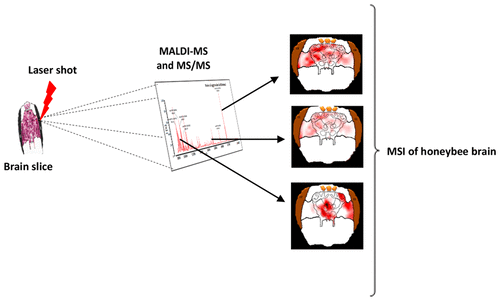当前位置:
X-MOL 学术
›
J. Proteome Res.
›
论文详情
Our official English website, www.x-mol.net, welcomes your
feedback! (Note: you will need to create a separate account there.)
MALDI Imaging Analysis of Neuropeptides in Africanized Honeybee (Apis mellifera) Brain: Effect of Aggressiveness
Journal of Proteome Research ( IF 3.8 ) Pub Date : 2018-06-01 , DOI: 10.1021/acs.jproteome.8b00098 Marcel Pratavieira 1 , Anally Ribeiro da Silva Menegasso 1 , Franciele Grego Esteves 1 , Kenny Umino Sato 1 , Osmar Malaspina 1 , Mario Sergio Palma 1
Journal of Proteome Research ( IF 3.8 ) Pub Date : 2018-06-01 , DOI: 10.1021/acs.jproteome.8b00098 Marcel Pratavieira 1 , Anally Ribeiro da Silva Menegasso 1 , Franciele Grego Esteves 1 , Kenny Umino Sato 1 , Osmar Malaspina 1 , Mario Sergio Palma 1
Affiliation

|
Aggressiveness in honeybees seems to be regulated by multiple genes, under the influence of different factors, such as polyethism of workers, environmental factors, and response to alarm pheromones, creating a series of behavioral responses. It is suspected that neuropeptides seem to be involved with the regulation of the aggressive behavior. The role of allatostatin and tachykinin-related neuropeptides in honeybee brain during the aggressive behavior is unknown, and thus worker honeybees were stimulated to attack and to sting leather targets hung in front of the colonies. The aggressive individuals were collected and immediately frozen in liquid nitrogen; the heads were removed and sliced at sagittal plan. The brain slices were submitted to MALDI spectral imaging analysis, and the results of the present study reported the processing of the precursors proteins into mature forms of the neuropeptides AmAST A (59–76) (AYTYVSEYKRLPVYNFGL-NH2), AmAST A (69–76) (LPVYNFGL-NH2), AmTRP (88–96) (APMGFQGMR-NH2), and AmTRP (254–262) (ARMGFHGMR-NH2), which apparently acted in different neuropils of the honeybee brain during the aggressive behavior, possibly taking part in the neuromodulation of different aspects of this complex behavior. These results were biologically validated by performing aggressiveness-related behavioral assays using young honeybee workers that received 1 ng of AmAST A (69–76) or AmTRP (88–96) via hemocele. The young workers that were not expected to be aggressive individuals presented a complete series of aggressive behaviors in the presence of the neuropeptides, corroborating the hypothesis that correlates the presence of mature AmASTs A and AmTRPs in the honeybee brain with the aggressiveness of this insect.
中文翻译:

非洲蜜蜂(Apis mellifera)脑中神经肽的MALDI成像分析:攻击性的影响
蜜蜂的侵略性似乎受到多种基因的调节,这受到不同因素的影响,例如工人的多种族主义,环境因素以及对警报信息素的反应,从而产生了一系列行为反应。怀疑神经肽似乎与攻击行为的调节有关。在攻击行为期间,阿托伐他汀和速激肽相关的神经肽在蜜蜂脑中的作用是未知的,因此刺激工蜂攻击并挂在菌落前面的皮革目标上。收集好斗的个体,并立即冷冻在液氮中。取出头,按矢状切成薄片。将脑片进行MALDI光谱成像分析,并且本研究的结果报道了将前体蛋白加工成成熟形式的神经肽AmAST A(59–76)(AYTYVSEYKRLPVYNFGL-NH2),AmAST A(69–76)(LPVYNFGL-NH2),AmTRP(88– 96)(APMGFQGMR-NH2)和AmTRP(254-262)(ARMGFHGMR-NH2),它们在攻击行为期间显然作用于蜜蜂大脑的不同神经桩,可能参与了这种复杂行为不同方面的神经调节。这些结果通过使用年轻的蜜蜂工人进行侵略性相关的行为分析而得到生物学验证,该工人通过溶血素接受了1 ng AmAST A(69-76)或AmTRP(88-96)。在没有神经肽的情况下,未曾被认为具有侵略性的年轻工人表现出一系列完整的侵略性行为,
更新日期:2018-06-01
中文翻译:

非洲蜜蜂(Apis mellifera)脑中神经肽的MALDI成像分析:攻击性的影响
蜜蜂的侵略性似乎受到多种基因的调节,这受到不同因素的影响,例如工人的多种族主义,环境因素以及对警报信息素的反应,从而产生了一系列行为反应。怀疑神经肽似乎与攻击行为的调节有关。在攻击行为期间,阿托伐他汀和速激肽相关的神经肽在蜜蜂脑中的作用是未知的,因此刺激工蜂攻击并挂在菌落前面的皮革目标上。收集好斗的个体,并立即冷冻在液氮中。取出头,按矢状切成薄片。将脑片进行MALDI光谱成像分析,并且本研究的结果报道了将前体蛋白加工成成熟形式的神经肽AmAST A(59–76)(AYTYVSEYKRLPVYNFGL-NH2),AmAST A(69–76)(LPVYNFGL-NH2),AmTRP(88– 96)(APMGFQGMR-NH2)和AmTRP(254-262)(ARMGFHGMR-NH2),它们在攻击行为期间显然作用于蜜蜂大脑的不同神经桩,可能参与了这种复杂行为不同方面的神经调节。这些结果通过使用年轻的蜜蜂工人进行侵略性相关的行为分析而得到生物学验证,该工人通过溶血素接受了1 ng AmAST A(69-76)或AmTRP(88-96)。在没有神经肽的情况下,未曾被认为具有侵略性的年轻工人表现出一系列完整的侵略性行为,











































 京公网安备 11010802027423号
京公网安备 11010802027423号